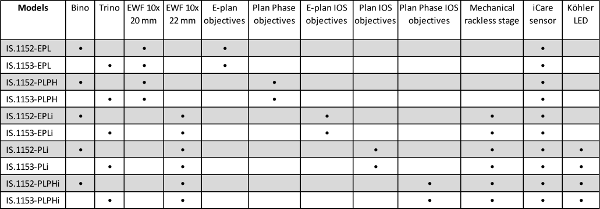Microscope review: iScope IS1153-PLi trinocular
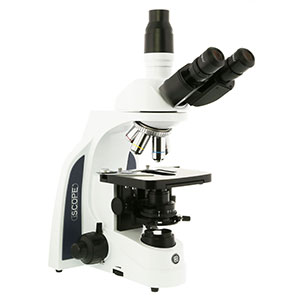
Amateur scientists and hobbyists rarely get to try new microscopes for an extended period before buying them and often don’t have the opportunity to compare different set-ups. I thought it may be helpful to write a review for the benefit of anyone thinking of getting one. My aim is to give an honest and relatively impartial overview – with the caveat that we sell the product on my website www.micro-science.co.uk and therefore can never be truly impartial.
The Dutch company Euromex supply a range of microscopes and accessories and have just released a new microscope called the iScope with many updated features. Euromex is not as well known in Britain as other brands but have been around for quite a while (since 1966) and have recently passed the production mark of 1,000,000 microscopes. In my experience so far as a stockist, Euromex have been very helpful – providing very good support and replying to emails in a timely manner – more on this later.
As a field mycologist, I was getting a little frustrated with the Nikon E100 I have been using for the last couple of years. Although the resolving power of the E100 was enough to see ornamentation on Russula spores, I could never really see detail as clearly as would have liked.
When the new iScope was ready in April 2015, I was eager to test one and see how it would perform compared with my older Nikon. It is a little unfair to compare the the iScope directly with the E100 as they were not built in the same year and technology moves on. However as many people may be thinking of upgrading from an older microscope with a halogen bulb, I think the comparison is still useful in the real world.
Comparison of features:

First impressions
The microscope arrived well packaged and appeared to be very well made. The polystyrene packing can be saved and used as a case if needed. The instruction manuals are produced in good comprehensible English but are very brief. The objectives were already screwed in to place and objective storage boxes were also provided. Blue and Green filters were also included. On this microscope I also specified an additional x60 eyepiece – the standard microscope only comes with 4 lenses – the x4, x10, x40 and x100 oil PLAN objectives. A carrying case and a 5MP CMEX camera were also added as extras.
Set up was quick and straightforward with the Allen keys provided. My first test was Russula spores stained with Melzer’s reagent. The most noticeable difference is the quality and brightness of light – it is much, much whiter than halogen. The next thing is the much wider field of view from the 10×22 eyepieces than the Nikon’s 10×18 (the first number refers to the magnification and the second number refers to the width of the eyepiece lens in mm). This means that you do not need to move around the slide as much to identify regions of interest.
Looking at Russula spores provided very good results and the spore ornamentation was clearly visible. This was a promising start. Within another half an hour I had mounted the camera, installed the software and taken the picture below.
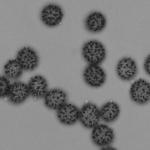
Russula ochroleuca spores x 1000. Photo taken using the 5MP CMEX camera and supplied image software (including stacking feature). Stacking software allows images to be combined to increase the depth of field (DoF) and bring more of the image into focus (The photo shows the result of 3 images combined or “stacked”). Single images show as much detail but not all parts will be in focus simultaneously.
As you can see, the resolving power is excellent and the ornamentation and reticulation are clearly visible.
Taking the train
The British Mycological Society spring foray provided me with an excellent opportunity for six days of constant microscope use to really road test the iScope, so I packed the (quite large) carrying case and set off. Travelling was made easier using a good-quality luggage trolley with a suitcase on top. I would recommend booking in advance and travelling first class if possible to make sure there is plenty of luggage storage space available. You will have no problems if you travel by car.
The 5MP camera also fits in the case along with reagents and sundries so another camera bag was not necessary. However the case measures a healthy 56 x 56 x 26cm. Weight TBC.
Set up
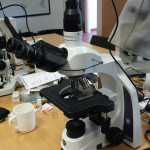
The microscope comes prepared for transit with the stage locked in place using a foam pad underneath and the “slide protection handle” set. The handle is a vertical lever on the left side of the microscope next to the focus control – push it forward to release it and then you will be able to raise the stage to remove the foam packing. Keep the foam for future transit.
The camera is very quick to attach using the tube provided and the USB 2.0 cable was connected to an Asus Zenbook UX305 with 128GB SSD running Windows 8.1 (Note: the software was only listed as being suitable for up to Windows 8 and would not run at full resolution with Windows 8.1. I contacted Euromex and they replied the same day and provided a link to functioning updated software within 48 hours! Great service).
Hands on
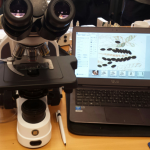
The microscope really is a joy to use. The eyepieces are “high-focus” which gives a greater working distance – this reduces the chances of accidentally touching the glass and marking it or eyelashes getting in the way. A big improvement over the Nikon.
The stage also felt very well built and responsive with coarse and fine focus controls either side (the right side one has a mini-control button with indentations for finger tips giving excellent control – another feature I really liked).
This higher-end microscope also comes with Kohler illumination which helps to improve contrast. More information on setting up the condenser for Kohler is provided in the user manual but it is quite straightforward. Lower specified models in the range are supplied with standard illumination.
Results
All images are scaled down to 800px wide to make them web friendly. Origninal size is 2584 x 1936 and higher quality

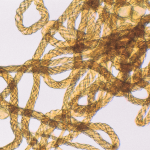
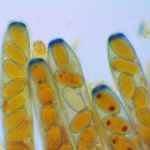
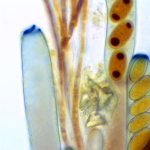
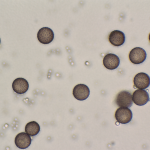
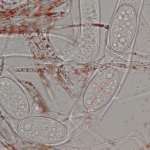
As you can see from the last photo above, large transparent spores of the ascomycete fungus Sarcocypha austriaca are visible measuring 29.8 x 16.2 um (micrometres) Measurements were taken using Piximetre – recommended free spore measuring software.
Globules of red carotenoid pigment are also clearly visible in the thinner tubes (paraphyses). This is what gives the cup fungus its bright red colour. These globules were very well defined and I was easily able to measure one to an incredible 0.44 um diameter (see across to the left and about level with the top of the labelled spore. To put this in perspective, E.coli (considered an average size bacterium) is 2 x 0.5 um – meaning it may be possible to distinguish individual bacteria with this microscope (if my calculations are correct and if the bacterium is stained appropriately).
Other features
There is a cable tidy at the back of the microscope allowing everything to be packed away nicely. The microscope also has a sensor (activated by an “ECO” button on the side) which switches the light off when the user is away but no instructions are provided and I have yet to see it work. However, as the light only uses 3W of power, I’m not sure this is really needed.
The optional extra 60x lens
This is the only real problem I encountered. It is a fraction too long for microscope and catches the cover slip on the way past. The 100x lens does not do this. Focusing out before switching lenses is possible but it interrupts workflow and is easy to forget, leading to specimen disruption. Hopefully this can be avoided by replacing with an alternative 60x objective from Euromex or another source. Even when properly adjusted, I noticed that the contrast achieved by the 60x was not as great as the other objectives – however this lens is operating at the limit of what is a possible without oil immersion and therefore this may be just be par for the course with this size lens. (UPDATE: 7/5/2015 – Euromex are currently looking into this issue. UPDATE: 4/09/2015 – well it took a while but it is now resolved. The replacement x60 has arrived and works very well. The working distance is good and the image quality and resolution are as good as the other objectives).
As you can see from the example images, this really is a very good microscope. Viewing the images through the eyepieces is a joy and the whiteness of the LED illumination feels much more natural than the yellow of a halogen light. I also noticed my eyes did not get tired even after many hours use which suggests that the claimed lack of infrared in LED’s really is easier on the eye.
The overall build is robust, well finished and gives a very stable image. There is very little negative to say about the microscope except for the issues outlined regarding the 60x objective. The iScope 1153i is the best microscope I have tested so far and the one I choose to use on a daily basis – there can be no better recommendation than that.
This microscope and case are relatively large and heavy to take on the train but it is possible if you don’t want to compromise on image quality. Travelling microscopists without a car may prefer one of the models below in the “Other models” section.
The model tested is the top of the iScope range. Lower specification iScope models are also available – the information below is taken from their website.
The iScope® is available in different configurations. Thanks to the high resolving power of the objectives and the 3W NeoLed transmitted LED illumination, these microscopes can be used for all kind of demanding applications as well for fundamental research. Please find below a summary of the specifications
EWF10x/22 mm or EWF10x/20mm eyepieces
Binocular and trinocular heads
Quintuple nosepiece
E-Plan EPL 4x/0.10, 10x/0.25, 20x/0.40, S40x/0.65, S100x/1.25 oil-immersion DIN objectives
E-Plan EPL IOS 4x/0.10, 10x/0.25, 20x/0.40, S40x/0.65, S100x/1.25 oil-immersion DIN objectives
Plan PL IOS 4x/0.10, 10x/0.25, 20x/0.40, S40x/0.65, S100x/1.25 oil-immersion DIN objectives
140 mm x 160 mm stage equipped with integrated 79 x 52 mm mechanical stage
216 mm x 150 mm rackless stage equipped with integrated 79 x 52 mm mechanical stage
Height adjustable Abbe condenser N.A. 1.25
Coarse and fine height adjustment
Diascopic intensity adjustable 3W NeoLED™ illumination with internal 85V-240V power supply
iCare sensor for energy saving
CSS – Cable Storage System
Models IS.1152-EPL and IS.1153-EPL are supplied with E-Plan objectives for bright field applications
Models IS.1152-EPLi and IS.1153-EPLi are supplied with E-Plan IOS objectives for bright field applications
Models IS.1152-PLi and IS.1153-PLi are supplied with Plan IOS objectives for bright field applications
Other models from Euromex
I have also tested the BioBlue Digital microscope LED Bino 4/10/40/100x obj. BB.4260 which is a more compact and lighter model with true portability (it can be battery powered). It is much easier to transport but the lack of weight makes the image less stable and the objectives are of a lower specification meaning aberration can be seen at the edge of the field of view.
The intermediate BioBlue.Lab range look a promising compromise between the BioBlue and iScope ranges as they provide a lighter scope but with the (big) benefit of PLAN objectives. The model BB.1152-PLi looks like it may a good specification for the roving mycologist. I hope to review one of these soon.
UPDATE 7/5/15: Euromex have also suggested the Novex B_Plus 86.099-LED as a good alternative for mycology as it comes with a rechargeable NeoLED light source, quintuple nosepiece and PLAN objectives.
UPDATE 26/1/17: My iScope is still going strong after almost 2 years of use – no mechanical or optical issues. Achromatic objectives do have their limits when it comes to more serious microphotography though. Please see this camera review for more information on reducing chromatic aberration from achromatic objectives.
Glossary of terms
SEMI-PLAN : objectives have an 80% flat field. Aberrations are generally located in the outer 20% of the field of view.
PLAN : objectives have a flat field about the centre 95% of the image and for all practical purposes are free of aberration. Their more complex design makes them more expensive to manufacture.
Infinity-corrected optics: some advanced microscopy techniques require additional components to be placed in the light path. Infinity-corrected optics allow extra components to be added to the light path without degrading the image quality.
Kohler illumination: simply, this is a technique for ensuring a precise light path leading to greater image contrast. Setting the condenser height and field diaphragm correctly will achieve this. More information is available here http://en.wikipedia.org/wiki/Köhler_illumination


